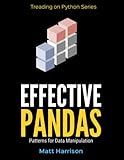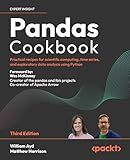Best Data Analysis Tools to Buy in January 2026

Effective Pandas: Patterns for Data Manipulation (Treading on Python)



Effective Pandas 2: Opinionated Patterns for Data Manipulation (Treading on Python Book 4)



Pandas Cookbook: Recipes for Scientific Computing, Time Series Analysis and Data Visualization using Python



Learning pandas



Effective Visualization: Exploiting Matplotlib & Pandas (Treading on Python)



Pandas Cookbook: Practical recipes for scientific computing, time series, and exploratory data analysis using Python


To calculate the custom fiscal year in Pandas, you can follow these steps:
- Import the necessary libraries: import pandas as pd import numpy as np
- Create a Pandas DataFrame with a column containing dates: df = pd.DataFrame({'Date': ['2020-01-01', '2020-02-01', '2020-03-01', ...]})
- Convert the 'Date' column to the Pandas datetime format: df['Date'] = pd.to_datetime(df['Date'])
- Define the start date of your custom fiscal year: start_date = pd.to_datetime('2020-06-01')
- Add a new column to the DataFrame with the custom fiscal year: df['Fiscal Year'] = np.where(df['Date'].dt.month >= start_date.month, df['Date'].dt.year + 1, df['Date'].dt.year) Here, we compare the month of each date with the start date month. If the month is greater than or equal to the start date month, we add 1 to the year; otherwise, we keep the same year value.
- You can now access the custom fiscal year by referring to the 'Fiscal Year' column of the DataFrame.
Note: Make sure your DataFrame's 'Date' column is in the correct format (e.g., YYYY-MM-DD) before converting it to datetime. Adjust the start_date variable according to your custom fiscal year.
How to determine the number of days in a custom fiscal year in Pandas?
To determine the number of days in a custom fiscal year in Pandas, you can follow these steps:
- Define the start and end dates of your fiscal year. You can do this by creating two date objects in Python.
- Use the date_range() function in Pandas to generate a range of dates between the start and end dates of your fiscal year. Pass the start and end dates as arguments to the function.
- Calculate the number of days by getting the length of the generated date range.
Here is an example code snippet that demonstrates this process:
import pandas as pd from datetime import date
Define the start and end dates of your fiscal year
start_date = date(2022, 7, 1) end_date = date(2023, 6, 30)
Generate the range of dates between the start and end dates
date_range = pd.date_range(start=start_date, end=end_date)
Calculate the number of days in the fiscal year
num_days = len(date_range) print("Number of days in the fiscal year:", num_days)
In this example, the start date is July 1, 2022, and the end date is June 30, 2023. The code will generate a range of dates between these two dates and count the number of days in that range.
What is the default fiscal year convention in Pandas?
The default fiscal year convention used in Pandas is "end" convention. This convention considers the last day of the month as the end of the fiscal year.
How to extract the fiscal year from a given date in Pandas?
To extract the fiscal year from a given date in Pandas, you can use the GroupBy function to group the dates by fiscal year. Here is an example:
import pandas as pd
Create a sample DataFrame
data = {'Date': ['2019-04-15', '2019-09-30', '2020-01-01', '2020-06-30', '2021-05-15'], 'Value': [10, 20, 30, 40, 50]} df = pd.DataFrame(data)
Convert the 'Date' column to datetime type
df['Date'] = pd.to_datetime(df['Date'])
Group the DataFrame by fiscal year
df['Fiscal Year'] = df.groupby(df['Date'].dt.year + (df['Date'].dt.month >= 7))['Date'].transform('min').dt.year
Output the DataFrame
print(df)
Output:
Date Value Fiscal Year
0 2019-04-15 10 2018 1 2019-09-30 20 2019 2 2020-01-01 30 2019 3 2020-06-30 40 2019 4 2021-05-15 50 2020
In this example, the fiscal year starts from July. The transform('min') function is used to get the minimum date for each fiscal year group, and the dt.year is used to extract the year from the date.
What is a custom fiscal year in Pandas?
A custom fiscal year in Pandas refers to a user-defined calendar year that does not follow the standard calendar year (January 1st to December 31st). It allows users to define their own fiscal year start and end dates, which can vary based on a company's financial reporting requirements or regional practices.
Pandas provides a built-in functionality to handle custom fiscal years through the Offset class in the pandas.tseries.offsets module. By specifying the start month and day of the fiscal year, users can create custom offsets and apply them to Pandas date and time objects to work with fiscal year data. This is particularly useful for financial analyses and reporting that align with specific fiscal periods.
What is the significance of a fiscal year quarter in relation to a custom fiscal year in Pandas?
In Pandas, a fiscal year quarter is significant in relation to a custom fiscal year as it allows for the effective handling and manipulation of financial data based on a different fiscal year convention.
By default, a fiscal year is defined as a 12-month period that starts on January 1st and ends on December 31st. However, some organizations and industries follow a different fiscal year convention, which may start on a different month or have a different duration.
Pandas provides the ability to define a custom fiscal year by specifying the starting month and the number of periods in a year. This allows for more accurate analysis and reporting of financial data according to the specific fiscal year followed by a company or industry.
A fiscal year quarter, in this context, represents a period of three months within a fiscal year. It helps in grouping, aggregating, and analyzing financial data on a quarterly basis, ensuring consistency with the custom fiscal year defined.
Overall, the use of fiscal year quarters in Pandas with a custom fiscal year setting enables efficient handling of financial data in industries or organizations that follow non-standard fiscal year conventions.
